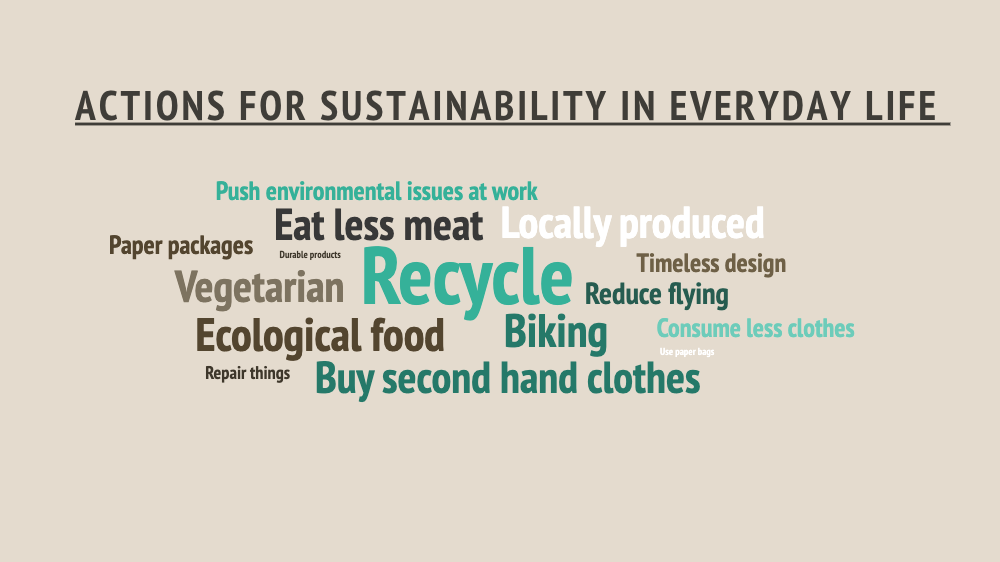
Field work. Getting insights from qualitative deep interviews.
A user research learning journey within user experience at Hyper Island
What kind of change does people want to engage in? — In this project you will read about a user centered field work project to understand people’s opinions and feelings for a sustainable lifestyle. From brief to recommendations.

-

The task.
An organization within environmental awareness wants to find and involve a new segment of members. They have an impression there are target groups which they have not yet connected to with a potential to contribute to a more sustainable lifestyle. The organization needs to understand what users truly want, to move in the right direction, to get that audience on board.
-

Persona.
The organization has made a persona of the users they believe they want to connect to and to understand their triggers. The persona is described as a 35 year old person, living with her partner and children. She is busy working full time and likes socializing. She is concerned about the climate change but wants an effortless way of making good.
-

Assumptions and Prio Needs.
Assumptions of needs was created. The needs was organized into a chart, sorted and graded in terms of importance and known/unknown. The important and unknown needs were focused on. By making a these assumptions it will be a guidance to what to look for during the qualitative interviews.
The important/unknown needs :
Having an effortless way of making good.
Motivation and understand the impact of her actions.
Reduce environmental impact and reduce co2 emissions.
Added knowledge.
-

Screener survey.
With the brief and hypothesis in mind the screener questions was created to recruit the right persons for the interview and also to understand the challenges within the field.
-

Actions for sustainability in everyday life.
Understanding what actions people already are doing for a sustainable lifestyle becomes a base for the further work.
-

Concern vs action.
It was obvious that the difference between concern and actions were quite big. Conclusion is that people want to do more action than they do. That was a great starting point and also helped choosing the most relevant people to interview.
-

Reasons for not taking action.
To understand the reason for not taking action is a way of investigating into what is lacking and what can be improved. To get to know the user and her needs.
-

Hypothesis & "We know we are right when.."
To create good findings from the interviews we need create open questions which are well anchored in both the:
Hypothesis starting with “We believe..”
The experiment phrase “We will know we are right or wrong when…”
With these in mind the open questions will generate answers from the unknown and important that we are eager to learn about.
-

Card sorting
In the end of each session each interviewee was presented ideas through cards, which they should place within the sections Love it!, Nice to have! or No! along with describing the reason why. This gave a quick indication what the users thought of different ideas.
People that was a great fit for the interview was invited to participate in the deep interviews to understand the needs further, scooping for insights.

Synthesize Qualitative.
When there is a trend in what we are told during the interviews, we see a pattern and from there we create an insight. From the insight a principle is born, which can be described as a rule to follow or avoid. This is our gold mine, to present to the organization, what will be the next step in their journey to achieve their goals for the project.

HYPOTHESIS 1.
We believe that: It is important to the user to understand which action gives the most positive impact on the environment.
“It’s sometimes hard to work out what you can do yourself to make a change on the environment that is big enough.”
“We don’t know if it’s really environmentally friendly or not. Some people say yes, some people say not, but we just use it”
“Inte ens kommunerna kan komma överens om CO2-beräkningar så det blir lätt så att vi gör oss en otjänst om vi tror att vi kan räkna alla mål och planer..”

INSIGHT
Users don´t know what action is better and more effective than the other.
PRINCIPLE
Let the user know what action makes the most impact.

HYPOTHESIS 2.
We believe that: The user does not feel motivated enough to really change her behaviour to reduce c02 emissions or impacts on the environment.
“Then people stop caring about environmental issues as much because I see environmental issues as being like negative to their life. When it pinches on you, then you stop looking too towards it in a positive way. So there’s so many changes that need to be made on a larger scale and people actually see how it’s going to help rather than plastic bag tax.”
“And then that impact … more than a thousand times more than the individual …What what can I do? Like, I’m not very impactful person.”
“Everyone else is going to the zoo. So I’m going to go to the zoo. … It feels like pointless when you’re the only one trying to make it.”

INSIGHT
Users believe they are contributing to live a sustainable life but feel it is not enough and that change is needed in a higher system level.
PRINCIPLE
Let the users discover possibilities to take part in changes in higher system levels.

HYPOTHESIS 3.
We believe that: The user wants an effortless way of making good.
“Det borde inte vara liksom “Ska du välja ekologiskt eller inte” utan bara finnas någonting och det ska vara hållbart.”
“So it’s easy to be sustainable when it’s convenient, isn’t it? I think I will have less of an environmental impact when it’s the easier alternative.”
“Jag tror att hållbarhet är för abstrakt för att det ska påverka vardagens val. Jag tror att när hållbarheten passar in i vad människor vill, så tar man det.”

INSIGHT
Users are concerned about sustainability but are living a busy life and find it hard to easily engage and hesitate to change their lifestyle.
PRINCIPLE
Let users engage in a convenient way and make it a non-choice to contribute to positive change.

HYPOTHESIS 4. ADDITIONAL
Additional findings: Users experience that they want to do tangible things and see and understand that their actions have a positive impact and not a negative.
“Would go planting trees if I could go and plant trees everywhere. …. I’m not sure how much of impact I would have thought”
“Often I find something that’s actually tangible that, you know, you’re getting a result from and not just a note to pat yourself on the back to say you can feel a bit more. It’s done. … immediate impact and then it can filter into more long term and changes in habits.”
“Just Östersjön att den är övergödd, att man skulle kunna vara med i nåt sånt hjälpprojekt så man ser att det går framåt.”

INSIGHT
Users want tangible projects and actions to engage in.
PRINCIPLE
Let users experience tangible and positive consequences of their actions.

Recommendations to the organization.
The user research showed that the user group experience that they have a limited time but are still trying hard to live a sustainable life. Though, users are questioning if it is enough to recycle, buying second hand clothes and to fly less. The most interesting insight seem to be that users think that the changes need to be done on different levels, both as individuals and in political and structural ways.
Users wish to get more information and knowledge, to widen their perspective within sustainability.
Also the wish to do something more tangible and visible came clear. To see the change that is made. I would suggest you to look into tangible projects where users can engage in new innovations, planting trees projects or healthy oceans e.g. cleaning the Baltic sea. And then looking back, being able to see the results.

Next steps.
How might we show the user what action makes the most impact.
How might we create possibilities for the user to take part in changes on a higher system level.
How might we let users conveniently engage and contribute into positive change.
How might we create tangible actions for users to take part in.

